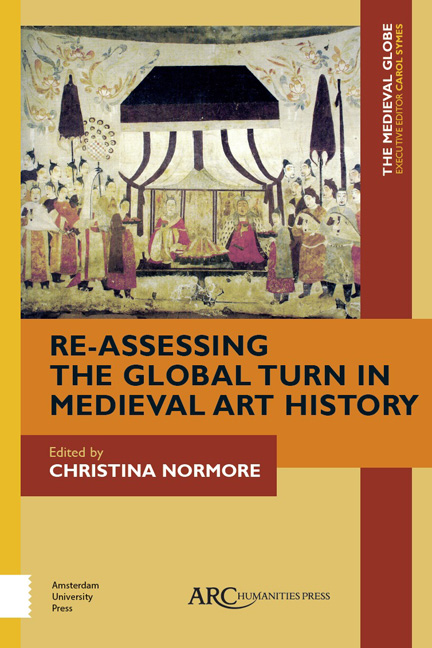Book contents
- Frontmatter
- Contents
- List of Illustrations
- Editor’s Introduction: A World within Worlds? Reassessing the Global Turn in Medieval Art History
- A Camel’s Pace: A Cautionary Global
- The Fatimid Holy City: Rebuilding Jerusalem in the Eleventh Century
- Worldliness in Byzantium and Beyond: Reassessing the Visual Networks of Barlaam and Ioasaph
- Exchange of Sacrifices: West Africa in the Medieval World of Goods
- The Beryozovo Cup: A Byzantine Object at the Crossroads of TwelfthCentury Eurasia
- Mobile Meanings: A Global Approach to a Dagger from Greater Syria
- Global Medieval at the “End of the Silk Road,” circa 756 CE: The Shōsō-in Collection in Japan
- Response: Medievalists and Early Modernists—A World Divided?
- Index
Worldliness in Byzantium and Beyond: Reassessing the Visual Networks of Barlaam and Ioasaph
Published online by Cambridge University Press: 23 January 2021
- Frontmatter
- Contents
- List of Illustrations
- Editor’s Introduction: A World within Worlds? Reassessing the Global Turn in Medieval Art History
- A Camel’s Pace: A Cautionary Global
- The Fatimid Holy City: Rebuilding Jerusalem in the Eleventh Century
- Worldliness in Byzantium and Beyond: Reassessing the Visual Networks of Barlaam and Ioasaph
- Exchange of Sacrifices: West Africa in the Medieval World of Goods
- The Beryozovo Cup: A Byzantine Object at the Crossroads of TwelfthCentury Eurasia
- Mobile Meanings: A Global Approach to a Dagger from Greater Syria
- Global Medieval at the “End of the Silk Road,” circa 756 CE: The Shōsō-in Collection in Japan
- Response: Medievalists and Early Modernists—A World Divided?
- Index
Summary
IF, AS PART of the global turn in art history, scholars redirect attention from “roots” to “routes,”then manuscript studies—as traditionally defined—might be in trouble. Conventional approaches have focused on the former, tracing recension schemas in an attempt to recreate the pictorial programs of lost archetypes from later copies, charting lines of pictorial “influence.” Individual manuscripts, according to this line of thought, are valued primarily as “witnesses” to lost originals as part of an alwayselusive recuperative agenda.While many scholars have offered cogent critiques of this genealogical method,the quest for origins still looms large, especially for manuscript traditions that span multiple cultural contexts.
The shortcomings of this method are thrown into especially sharp contrast by the corpus of manuscripts that form the core of this essay: the illustrated Greek copies of Barlaam and Ioasaph , a highdrama edifying tale based loosely on the life of the Buddha and translated into a staggering number of languages from around the medieval and early modern world. Specialized studies have attended to individual recension programs and modes of translation, while crosscultural overviews showcase the tale's wide currency. Alongside this wide terrain of textual diffusion is a significant, and somewhat unwieldy, body of visual material. Of the roughly 160 surviving Greek manuscripts of the text, a dozen were conceived as illustrated copies; their pictorial programs first received systematic attention from Sirapie Der Nersessian, whose study of 1937 is complemented by the recent critical edition of the Greek text by Robert Volk. Both are firmly anchored in a rootsorigins approach: Der Nersessian imagined a singular (lost) iconographic prototype of ca. 1000, whereas Volk posited five versions of the text and three distinct pictorial cycles. In addition to the illuminated manuscripts themselves, imagery drawn from the legend has found its way into a variety of other artistic contexts around the globe. Despite much rigorous scholarship, however, our understanding of this diffuse visual corpus is still somewhat fragmentary, and issues of transmission overshadow virtually all other potential research questions.
- Type
- Chapter
- Information
- Re-Assessing the Global Turn in Medieval Art History , pp. 57 - 96Publisher: Amsterdam University PressPrint publication year: 2018



